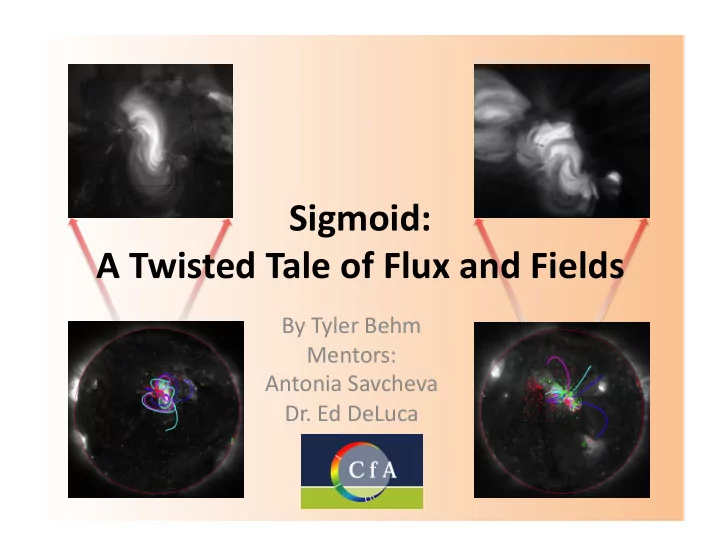

Sigmoid: A Twisted Tale of Flux and Fields By Tyler Behm Mentors: Antonia Savcheva Dr. Ed DeLuca
Etymology Sigm‐ ‐oid • Sigma • Having the shape or form of
Talk Outline Part 1: Background What is the “S” made of? How do sigmoids evolve with Ime? How can we study sigmoids? Part 2: REU Research Generate many computer models Find stable, best fit model
What is the “S” made of? Cooled plasma suspend by coiled magneIc fields ‐ + ‐ + Gold, T., and Hoyle, F., Mon. Not. R. astron. Soc, 120, 89 (1961)
How do sigmoids evolve with Ime? MagneIc reconnecIon 68% of erupIng acIve regions are sigmoids
How can we study sigmoids? NLFFF Modeling Force‐Free v × � Σ F ≈ q ( � B ) + Pressure ≈ 0 Sigmoid Lorentz Pressure Cross‐ Sec;on � j � � B = ⇒ = ⇒ � j = ∇ × � B PotenIal Linear Nonlinear
Tyler’s Work Significance and Goals Goals Find best fit NLFFF model in axial/poloidal flux space Significance Place boundaries on energy in field Predict stability of sigmoid Russell and Elphic, 1979
Tyler’s Work Two Sets of Data Magnetogram Fields X‐Ray Images Coronal Loops (ie Flux) Span axial/poloidal flux parameter space Same Sigmoid
Tyler’s Work Results from Computer Models 34 models to span flux parameter space Unstable Goodness = Less distance from field to flux = Green (on le/ charts) Unstable Aug 4, 2010
Conclusion What is the “S” made of? MagneIcally floated, cool coronal plasma How do sigmoids evolve with Ime? MagneIc reconnecIon and erupIons How can we study sigmoids? NLFFF Modeling + 1 intern = 2 sigmoids modeled
Special Thanks • NSF REU solar physics program at CfA, grant number ATM‐0851866 for funding • Kathy, Marie , and all REU organizers • Antonia and Ed for excellent mentorship • Aad for the Coronal Modeling Soiware • CfA for hospitality • Trae, Jonathan, and Alisdair for computer help
References Importance of Sigmoid Studies: Canfield et al. (1999, 2007) NLFFF Modeling: Savcheva, Van Ballegooijen (2009) QSL’s: Domoulin, Hénoux, Priest, Mandrini (1996) IllustraIons: solarmuri.ssl.berkeley.edu/ ~hhudson/cartoons/
Tyler’s Work Step 3: Make Sure It’s Stable Best Fit Model Higher Flux Model Aug 4, 2010
Tyler’s Work Step 4: Make Quasi‐Separatrix Layers If B‐fields were heads of hair… QSL’s would be parted hairlines. QSL
Tyler’s Work Step 4: Make Quasi‐Separatrix Layers Aug 4, 2010 Aug 10, 2010 Free Energy = 6.0×10 31 erg Free Energy = 3.4×10 31 erg Helicity = ‐5.2×10 42 Mx 2 Helicity = ‐2.3×10 42 Mx 2
Tyler’s Work Step 4: Make Quasi‐Separatrix Layers Aug 4, 2010 Aug 10, 2010 Free Energy = 6.0×10 31 erg Free Energy = 3.4×10 31 erg Helicity = ‐5.2×10 42 Mx 2 Helicity = ‐2.3×10 42 Mx 2
Recommend
More recommend